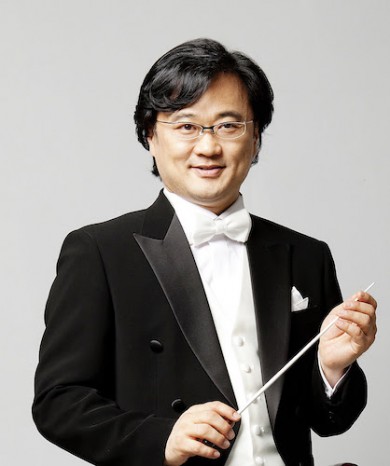Seraphic Fire serves up a fascinating sampler of Korean choral music
Western culture has deeply influenced Asian art over the past half century. On Wednesday night at Miami’s St. Sophia Greek Orthodox Cathedral, Seraphic Fire celebrated that melding of East and West in a program titled “Korean Choral Treasures.” Guest conductor Euijoong (E.J) Yoon traversed the sacred music, art song and traditional folk music of his country with a tip of the hat to folk Americana.
None of the members of the thirteen-voice choir speak the Korean language but, in just five days of rehearsal, they exhibited a vocal ease totally comparable to their performance of the Latin and English works that form the group’s core repertoire. More than a mere novelty, these scores and arrangements from the Korean diaspora were superbly crafted gems, displaying genuine mastery of choral writing.
Artistic director of the National Chorus of Korea, Yoon studied at the University of Cincinnati College Conservatory of Music. His superb delineation of inner timbres and voicing, rhythmic snap, and ability to achieve the most delicate and supple vocal effects were consistently impressive.
Yoon commenced the evening with two contrasting examples of sacred music by Hye-won Woo, one of South Korea’s leading female composers. With insistent repetitive rhythms, “Cum Sancto Spiritu” from her Gloria suggested Carl Orff’s Carmina Burana spiced with a whiff of contemporary minimalism. Paul John Rudoi’s throbbing tenor solo and the voluminous sonority immediately established Yoon’s mastery of choral textures. Even in Woo’s oft-repeated figures, there was subtle dynamic shading and the bracing sound of the female voices were thrilling as they soared over the ensemble.
Woo’s Requiem aeterna is a large-scale setting that hearkens back to Renaissance vocal writing while moving forward into modernist harmonies. Along the way, moments of exposed low bass voices suggested Russian orthodox chant and a gracious melodic fragment emerged among Woo’s finely constructed lines. The tonal depth and agility of Aaron Merritt’s cello underpinned the music’s shifting emotions and the warmth of the women’s voices contributed to the aura of rapt spirituality. As in last season’s performance of Bach’s St. Matthew Passion, the purity and ethereal beauty of Nola Richardson’s soprano took the spotlight with fine solo contributions also by Sarah Moyer and Brenna Wells .
Indeed Moyer’s high, almost laser-like soprano was a consistent delight throughout the program, none more so than in Hye-young Cho’s art song “Senoya.” With a nod to Puccini, a haunting melody rises over an almost humming chorus—think Madama Butterfly. The broad melodic paths of Cho’s “Never Forget” are very much in the mainstream mode of such contemporary choral composers as Morten Lauridsen or Eric Whitacre. Yoon drew full, luminous choral textures from the singers, the sound engulfing the ornate sanctuary.
The folklike simplicity of Byung-hee “Oh’s Ummaya Nunaya” (Dear Mommy and Sister) was calmly joyous but the tragedy and divisiveness of the Korean War underpinned Myong-tae by Hye-won Woo. The driving chords of Anna Fateeva’s piano suggested the churning sea, a metaphor of refuge from violence and injury. In solo writing that is both reflective and an outcry, Steven Eddy’s mellow timbre and the extraordinary agility of Enrico Lagasca’s contrasting bass voice were riveting. The Asian pentatonic scale (composed of five notes instead of seven) aided the music’s emotion filled swings of anger and consolation.
Oh’s artful arrangement of “Oh My Darling, Clementine” provided a John Rutter-like interlude of familiar popular culture, dressed up in new colors. The eloquence of Fateeva’s piano introduction set the stage for Moyer’s soaring solo, all the more effective for the setting’s unaffected restraint.
Transcriptions of four Korean folk songs concluded the program. The swaying beat of “Pong Dahng” (arranged by Hojun Lee) was followed by Byung-hee’s rousing version of “Que-ji-na ching-ching,” turned almost into a jam session by Yoon’s invigorating lead. Tenor Brad Diamond’s stentorian interjections and his trio with Moyer and alto Clara Osowski radiated the wide-eyed wonder and innocence of children at play.
If anyone in the audience needed waking up, Hy-jo Kim’s arrangement of “Gyeongbokgung Taryeong” did the trick. This anthem celebrating the reconstruction of a historic palace in Seoul was a great chase-the-blues-away prelude to “Airang,” one of the most popular of Korean tunes. Elegantly accompanied by Fateeva, the sumptuous melody painted a wide-screen evocation of mountains and lakes. Adding a pop beat for the final chorus, the concert concluded on a note of fun and multicultural celebration.
There are four remaining performances and choral connoisseurs should not miss this innovative and fascinating concert.
Seraphic Fire repeats “Korean Choral Treasures” 7 p.m. Thursday at Vanderbilt Presbyterian Church in Naples; 7:30 p.m. Friday at St. Philip’s Episcopal Church in Coral Gables; 7:30 p.m. Saturday at All Saints Episcopal Church in Fort Lauderdale; and 4 p.m. Sunday at All Souls Episcopal Church in Miami Beach. seraphicfire.org
Posted in Performances
Leave a Comment
Thu Mar 14, 2019
at 12:21 pm
No Comments





